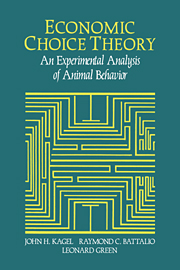Book contents
- Frontmatter
- Contents
- Preface
- Chapter 1 Introduction
- Chapter 2 Commodity-choice behavior I: Some initial tests of the theory
- Chapter 3 Commodity-choice behavior II: Tests of competing motivational processes and the representative consumer hypothesis
- Chapter 4 Labor-supply behavior I: Initial tests of the theory with some public policy implications
- Chapter 5 Labor-supply behavior II: Tests of competing motivational processes and earnings distributions for animal workers
- Chapter 6 Choices over uncertain outcomes
- Chapter 7 Intertemporal choice
- Chapter 8 Summing up
- Bibliography
- Index
Chapter 4 - Labor-supply behavior I: Initial tests of the theory with some public policy implications
Published online by Cambridge University Press: 22 March 2010
- Frontmatter
- Contents
- Preface
- Chapter 1 Introduction
- Chapter 2 Commodity-choice behavior I: Some initial tests of the theory
- Chapter 3 Commodity-choice behavior II: Tests of competing motivational processes and the representative consumer hypothesis
- Chapter 4 Labor-supply behavior I: Initial tests of the theory with some public policy implications
- Chapter 5 Labor-supply behavior II: Tests of competing motivational processes and earnings distributions for animal workers
- Chapter 6 Choices over uncertain outcomes
- Chapter 7 Intertemporal choice
- Chapter 8 Summing up
- Bibliography
- Index
Summary
In this chapter, we apply the commodity-choice model developed in Chapters 2 and 3 to issues of labor supply. As early as 1953, B. F. Skinner noted that ratio schedules of reinforcement in laboratory animals studied by psychologists correspond to piecework labor. Later, Logan (1964) noted a strong analogy between the “free-behavior situation” (behavior in a closed economy) and the way in which a “piece-rate worker controls his income.” (This work also produced some of the first demand curves for income as a function of effort price, although Logan did not refer to them as such.) In this chapter and in Chapter 5 we exploit the correspondence between piecework wage rates and ratio schedules of reinforcement in order to (a) test simple economic models of laborsupply behavior, and (b) explore issues in labor-supply behavior that because of both ethical and practical considerations are difficult to study experimentally with humans.
Whereas in Chapters 2 and 3 we described studies in which income and consumption opportunities were determined exogenously by the experimenter, and choices were between different commodities, here we are concerned with total earnings and the “work effort” required to obtain those earnings (where work effort is defined as both the time cost and physical effort required to obtain income). Simple piecework wage rate schedules that tie earnings directly to the work performed provide the most direct extension of the commodity-choice framework to labor-supply behavior. Organisms are again viewed as choosing between two or more positive outcomes, only in this case the outcomes are income and leisure. And once income and leisure levels are determined, work time is determined as well.
- Type
- Chapter
- Information
- Economic Choice TheoryAn Experimental Analysis of Animal Behavior, pp. 79 - 108Publisher: Cambridge University PressPrint publication year: 1995



